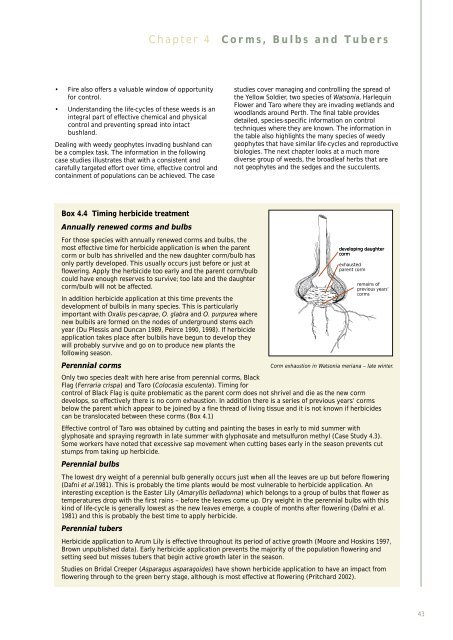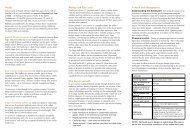Bushland Weeds Manual - Environmental Weeds Action Network
Bushland Weeds Manual - Environmental Weeds Action Network
Bushland Weeds Manual - Environmental Weeds Action Network
Create successful ePaper yourself
Turn your PDF publications into a flip-book with our unique Google optimized e-Paper software.
• Fire also offers a valuable window of opportunity<br />
for control.<br />
• Understanding the life-cycles of these weeds is an<br />
integral part of effective chemical and physical<br />
control and preventing spread into intact<br />
bushland.<br />
Dealing with weedy geophytes invading bushland can<br />
be a complex task. The information in the following<br />
case studies illustrates that with a consistent and<br />
carefully targeted effort over time, effective control and<br />
containment of populations can be achieved. The case<br />
Box 4.4 Timing herbicide treatment<br />
Annually renewed corms and bulbs<br />
Chapter 4 Corms, Bulbs and Tubers<br />
For those species with annually renewed corms and bulbs, the<br />
most effective time for herbicide application is when the parent<br />
corm or bulb has shrivelled and the new daughter corm/bulb has<br />
only partly developed. This usually occurs just before or just at<br />
flowering. Apply the herbicide too early and the parent corm/bulb<br />
could have enough reserves to survive; too late and the daughter<br />
corm/bulb will not be affected.<br />
In addition herbicide application at this time prevents the<br />
development of bulbils in many species. This is particularly<br />
important with Oxalis pes-caprae, O. glabra and O. purpurea where<br />
new bulbils are formed on the nodes of underground stems each<br />
year (Du Plessis and Duncan 1989, Peirce 1990, 1998). If herbicide<br />
application takes place after bulbils have begun to develop they<br />
will probably survive and go on to produce new plants the<br />
following season.<br />
Perennial corms<br />
studies cover managing and controlling the spread of<br />
the Yellow Soldier, two species of Watsonia, Harlequin<br />
Flower and Taro where they are invading wetlands and<br />
woodlands around Perth. The final table provides<br />
detailed, species-specific information on control<br />
techniques where they are known. The information in<br />
the table also highlights the many species of weedy<br />
geophytes that have similar life-cycles and reproductive<br />
biologies. The next chapter looks at a much more<br />
diverse group of weeds, the broadleaf herbs that are<br />
not geophytes and the sedges and the succulents.<br />
Only two species dealt with here arise from perennial corms, Black<br />
Flag (Ferraria crispa) and Taro (Colocasia esculenta). Timing for<br />
control of Black Flag is quite problematic as the parent corm does not shrivel and die as the new corm<br />
develops, so effectively there is no corm exhaustion. In addition there is a series of previous years’ corms<br />
below the parent which appear to be joined by a fine thread of living tissue and it is not known if herbicides<br />
can be translocated between these corms (Box 4.1)<br />
Effective control of Taro was obtained by cutting and painting the bases in early to mid summer with<br />
glyphosate and spraying regrowth in late summer with glyphosate and metsulfuron methyl (Case Study 4.3).<br />
Some workers have noted that excessive sap movement when cutting bases early in the season prevents cut<br />
stumps from taking up herbicide.<br />
Perennial bulbs<br />
The lowest dry weight of a perennial bulb generally occurs just when all the leaves are up but before flowering<br />
(Dafni et al.1981). This is probably the time plants would be most vulnerable to herbicide application. An<br />
interesting exception is the Easter Lily (Amaryllis belladonna) which belongs to a group of bulbs that flower as<br />
temperatures drop with the first rains – before the leaves come up. Dry weight in the perennial bulbs with this<br />
kind of life-cycle is generally lowest as the new leaves emerge, a couple of months after flowering (Dafni et al.<br />
1981) and this is probably the best time to apply herbicide.<br />
Perennial tubers<br />
developing daughter<br />
corm<br />
exhausted<br />
parent corm<br />
remains of<br />
previous years’<br />
corms<br />
Corm exhaustion in Watsonia meriana – late winter.<br />
Herbicide application to Arum Lily is effective throughout its period of active growth (Moore and Hoskins 1997,<br />
Brown unpublished data). Early herbicide application prevents the majority of the population flowering and<br />
setting seed but misses tubers that begin active growth later in the season.<br />
Studies on Bridal Creeper (Asparagus asparagoides) have shown herbicide application to have an impact from<br />
flowering through to the green berry stage, although is most effective at flowering (Pritchard 2002).<br />
43



